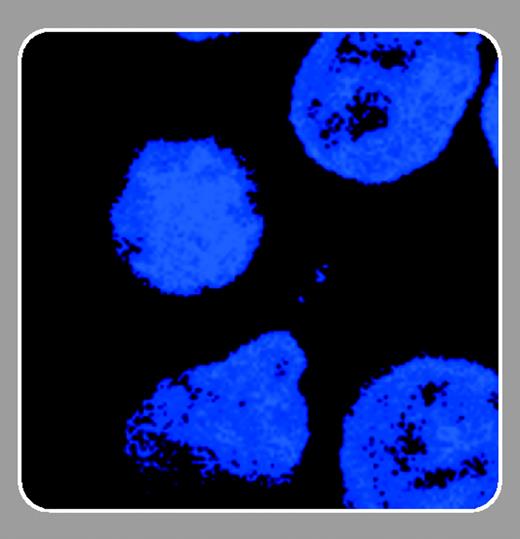NEOPLASIA
It is well established that mutations of the Fms-like tyrosine kinase 3 (Flt3) receptor tyrosine kinase occur in acute myelogenous leukemia (AML).1-3 Approximately 20% to 30% of AML cases are characterized by the presence of mutant Flt3 proteins with internal tandem duplications (ITDs) in the juxtamembrane domain of Flt3 (reviewed in Levis and Small,1 Stirewalt and Radich,2 and Gilliland and Griffin3 ). The presence of ITD mutations in Flt3 (Flt3-ITD) results in dimerization and phosphorylation of this receptor tyrosine kinase and ultimately the generation of downstream signals that promote leukemic cell growth.1-3 Such constitutive activation of Flt3 in leukemias expressing Flt3-ITD appears to have important pathogenetic implications and contributes to the development of the leukemic phenotype. Flt3-ITD mutations alone are not sufficient to cause AML. The presence of additional molecular abnormalities appears to be necessary, as shown by studies demonstrating that ectopic expression of Flt3-ITD in mouse bone marrow cells, followed by bone marrow transplantation, results only in the development of a chronic myeloproliferative disease.4 Nevertheless, expression of Flt3-ITD mutations has prognostic significance in AML and correlates with decreased response to chemotherapy and poor prognosis.3 FIG1
Because of the importance of Flt3-ITD mutations, extensive efforts have been made over the years to understand the mechanisms of generation of cellular signals by the constitutively activated Flt3 tyrosine kinase. Several mitogenic signaling pathways have been shown to act as downstream effectors for the Flt3 receptor tyrosine kinase,1-3 but the precise contribution of such signaling cascades in the development of the leukemic phenotype remains to be determined. In this issue of Blood, Takahashi and colleagues (page 4650) provide evidence for a novel mechanism by which Flt3-ITD mutations regulate induction of mitogenic signals. Their data provide the first evidence that Flt3-ITD regulates the function of the promyelocytic leukemia zinc finger (PLZF) transcriptional repressor and demonstrate that in the presence of Flt3-ITD mutations, the interaction of silencing mediator of retinoic and thyroid hormone receptors (SMRT) with the PLZF transcriptional repressor is blocked. Moreover, the authors establish that PLZF-mediated transcriptional repression is diminished and the suppression of leukemic cell growth by PLZF is abrogated. These data provide important new insights into the mechanisms of leukemogenesis by Flt3-ITD and suggest that inhibition of the function of PLZF and other transcriptional repressors that interact with SMRT may be of importance in leukemogenesis. A similar mechanism of reversal of PLZF repression may also apply in transformation by AML1-ETO,5 further indicating the functional relevance of SMRT-regulated repressors in the control of leukemic cell growth.
Altogether, the data from Takahashi et al raise the possibility that, beyond direct activation of mitogenic cascades, a primary mechanism by which abnormal oncoproteins promote leukemic cell proliferation is inhibition of the function of transcriptional repressors. It will be important to expand on these studies and, in future studies, determine whether other well-known oncoproteins also negatively regulate transcriptional repression. Further work in that direction may provide important new insights into the pathogenetic mechanisms of hematologic malignancies and facilitate the development of future translational approaches for the treatment of leukemias.


